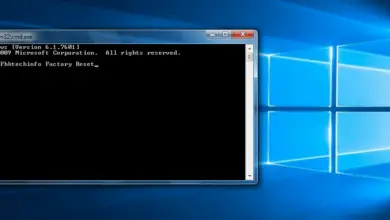How to download Windows 11 ISOs and the main uses of disk images
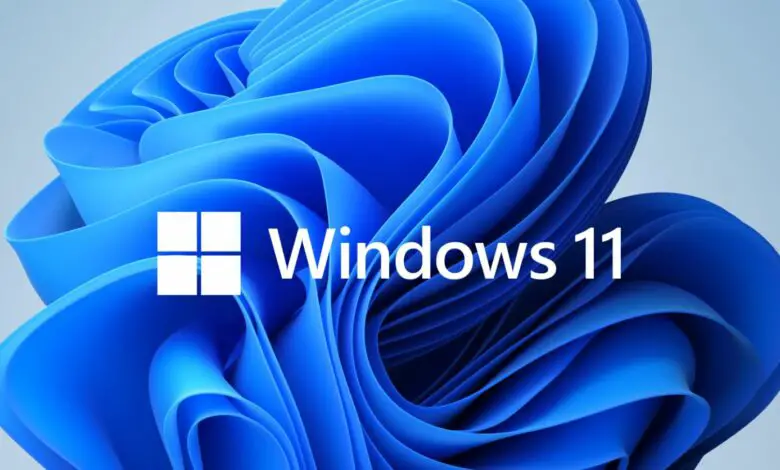
Microsoft released the first Windows 11 ISO last week, although there were already other alternative ways to get it, as we saw in the Windows 11 Installation Guide. It is another step that brings us closer to the launch of the final version that we expect by the end of the year.
If you are unfamiliar with this type of “image,” you should know that it is a sector-by-sector copy of the official OS installation/maintenance DVD, created as a disk image file that can be downloaded, stored, and transported.
You will find this type of image on the Internet as a single file with a .iso extension (the most used format, although there are others) and for any software, operating systems and applications, games, or other multimedia content.
In the case of operating systems, they are handy and allow several uses that we will review at the end focused on the new Windows 11. We have to warn that the version is still under development, in a preliminary phase (beta), and should only be used for tests discarding for the moment teams dedicated to production since its total stability is not guaranteed.
How to download the Windows 11 ISO
Official Website
Microsoft does not offer these images to the general public but reserves them for the Insider trial program subscribers. You only need a Microsoft ID account. We see the step by steps to obtain it:
- Access the Windows Insider Preview Downloads page.

- If the page does not authenticate, identify yourself with your Microsoft ID account.
- Select the version of the Insider Preview to build 22000.132. (We recommend the beta version, somewhat more stable than the development channel)
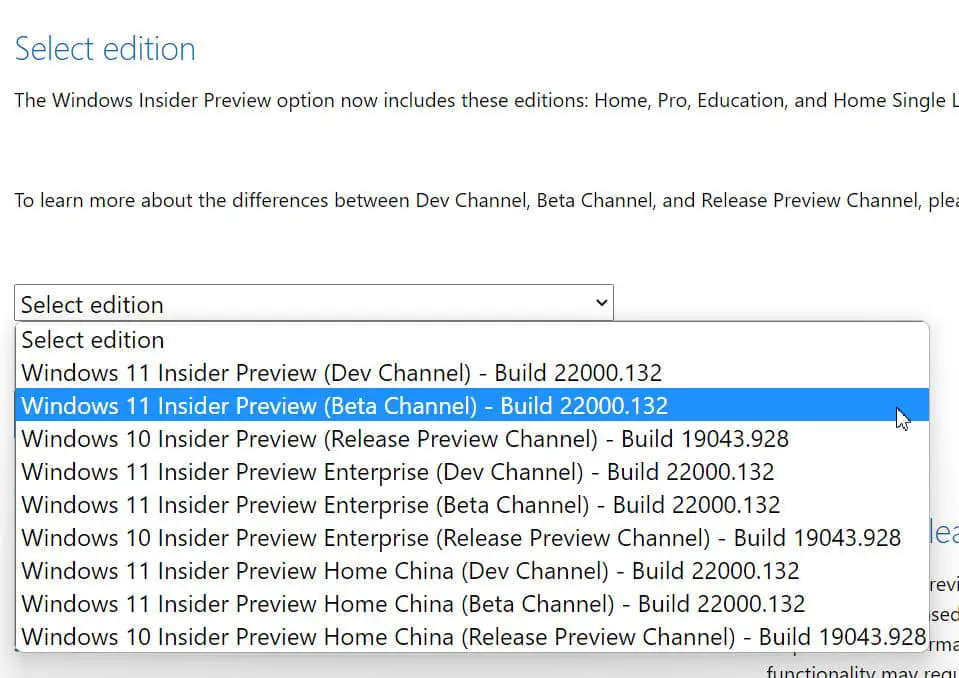
- Select the language.
- Download the resulting file “Windows11_InsiderPreview_Client_x64_es-en_22000.iso”.
Alternative 1
uupdump.net is a third-party site that offers a script to download the necessary files and convert them to a Windows 11 ISO. It is what we have been using before Microsoft officially provided the images. The files with which the ISO is created are official from Microsoft. As follows:
- Navigate to uupdump.net. The page offers versions in various channels to download, development (more advanced in the timeline), or beta (somewhat more stable) less stable) on multiple architectures.
- Below you will see the latest builds added. Select “Windows 11 Insider Preview 10.0.22000.160 (co_release) amd64”.

3. Click on it to select the Spanish language and the edition you prefer (Home or Pro).
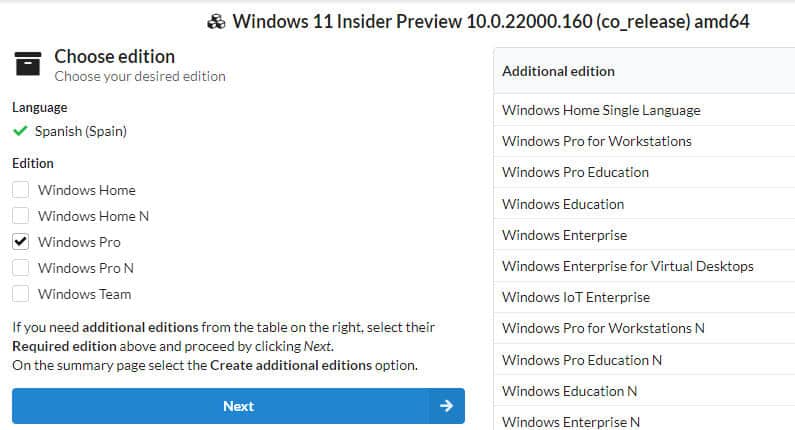
4. Select the download option: «Download and convert to ISO» to obtain a compressed ZIP file that will be used to get the image.
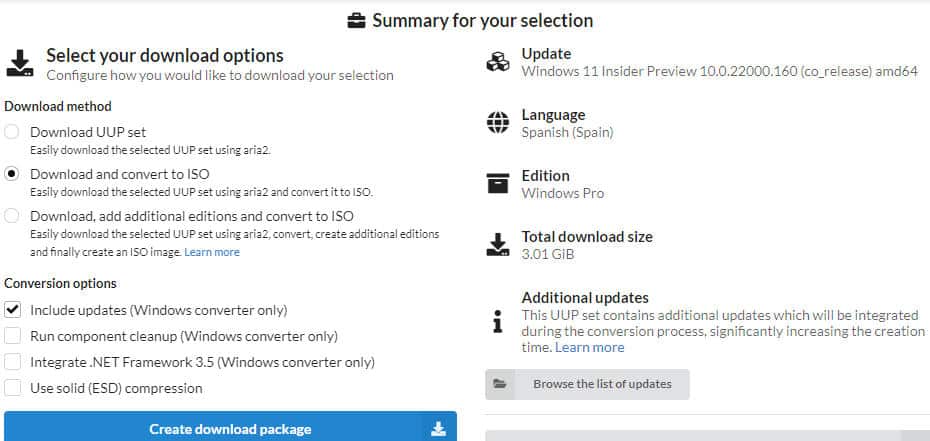
5. Unzip the file to a folder on your disk.
6. Go to the folder and double-click on the “uup_download_windows.cmd” file.
7. When you run the file, you’ll see a command prompt window open and a batch file run, downloading all the necessary files from Microsoft and doing a packaging that will create the Windows 11 ISO file.
Once Microsoft has started offering official images, the previous method is faster and easier than this one, but there you have it in case the other one fails you or if you don’t have a Microsoft ID account because this method works for any user.
Alternative 2
Microsoft also offers these files in other professional portals such as TechBench or the TechNet evaluation center, but you have to be subscribed to them. A developer has a great little app that we’ve been using for years to download images (both Windows and Office). The photos are official, the same ones offered by Microsoft, and are accessed as follows.
- Access the Heidoc.net page and download the “Windows ISO Downloader.exe” application. It is portable, and it does not need installation.
- There you will have access to Windows 7, 8.1, 10, and 11. Also, to the Office suite from version 2007 onwards and the versions for Mac.
Only the Windows 11 SDK is available, but it will inevitably be updated with the available images. Ideal for getting older Windows or Office images.
Windows 11 ISO uses
Clean facilities
Performing installations “from scratch” of the operating system is one of the primary uses. Before doing so, we will have to burn the disc image on a DVD (better on a USB stick) in a process known as “burning.” If you follow us, you should know it by heart. We review it:

- We use our favorite application, Rufus, which is free and works perfectly primarily with Windows images.
- Download and install. (You can also use the portable version)
- Insert the medium that you will use in the recording. You can use a DVD, but we recommend a pen drive or
- USB disk, faster and safer. Its minimum capacity must be 8 Gbytes.
- Run Rufus. You will see a straightforward interface in which you will first have to select the Windows image downloaded in the previous steps by selecting the “Boot choice.”
- It only remains to configure the rest of the options. GPT as “partition scheme,” target system “UEFI (not CSM), and NTFS or FAT32 as a file system. Click on start to get the installation media.
Upgrades
Another use of the media that we have created from the Windows 11 ISO is to perform updates from Windows 10, just as it is done from Windows Update. If you do, keep in mind that you will have to link the license to the new operating system and use a Microsoft ID account because, at the moment, it is only officially available to Insiders testers. If you try Windows 11 and don’t like it, or you want something more stable until the final version is released, you have ten days to go back to Windows 10 in a process carried out from the Configuration tool.
Third teams
The Windows 11 ISO or the created media can also be used on other computers, either for “clean” installations from scratch or to perform updates from Windows 10. The process is the same as if we do it on our computer.
Maintenance
The medium (we recommend creating it on a pen drive or USB disk rather than on a DVD) is used for installations/updates and system maintenance. These means are ideal for problem-solving, removal of malware, firmware update, the uninstallation of problematic drivers, applications, system updates, and in general scenarios where the system does not work or does not start correctly. The options are similar to the recovery functions within the system.
Virtual machines
Virtualization is a fast, comfortable, and safe method for executing software. It is especially indicated for testing unstable systems or applications such as Windows 11 since it does not affect the installed operating system that you use on a day-to-day basis and, in addition, it does not It is limited to Windows and offers the ability to test Windows 11 from a Linux or macOS machine.
Also, the media creation step is not required, and the downloaded Windows 11 ISO is used directly, loading it into some of the available commercial or free virtualization solutions.


